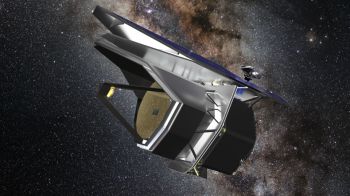Research news
NASA pick proposal involving Sussex scientists for further study, as they seek to address ‘secrets of the universe'
By: Stephanie Allen
Last updated: Thursday, 24 October 2024

Spacecraft: NASA/JPL-Caltech; Background: ESO/S. Brunier
A study involving Sussex scientists has been selected by NASA as one of two proposals being considered for a major $1billion astrophysics probe mission to help unlock the ‘secrets of the universe’.
The American space agency selected two proposals out of a possible eight for further study. Each of the proposals will receive $5million to conduct a 12-month mission concept study before one will be chosen by NASA to become a $1billion space probe mission, launching in 2032.
The Probe far-Infrared Mission for Astrophysics (PRIMA), is engaging with a UK consortium including researchers from the University of Sussex, Cardiff University, Imperial College, RAL-Space, Imperial College, University of Oxford, University of Leicester and University College London.
PRIMA is a proposal for an observatory that will feature a 1.8 metre telescope capable of studying far-infrared (FIR) wavelengths to ‘unveil our cosmic origins’. Scientists believe it could provide data that fills a gap between existing observatories like the famed James Webb Space Telescope, and radio telescopes.
Infrared is electromagnetic radiation, with wavelengths longer than that of visible light. Far infrared refers to the longest wavelengths within the infrared spectrum. By studying the radiant energy that only emerges in the far-infrared, astronomers will be able to address questions about astronomical processes that are happening at lower temperatures and hence study the origins and growth of planets, supermassive black holes, stars and cosmic dust.
Professor Seb Oliver, Deputy Pro Vice Chancellor of Research and Professor of Astrophysics at the University of Sussex led the UK engagement, funded by the UK Space Agency, with three FIR concepts that were being proposed. He is now leading the UK consortium, and spearheading work at Sussex which could be vital to the project’s progression. He said: “We are delighted that the PRIMA concept has been selected for further study by NASA.
“The UK has an amazing track record in developing new space technology and providing advanced data analysis for astrophysics missions. A UK involvement in a mission like PRIMA will ensure UK astronomers can maintain their pre-eminent role at the forefront of astrophysics.
“A FIR mission would be the first in operation after two decades – the last FIR mission was from 2009-2013. It will allow astronomers to see processes in galaxies, stars and planetary systems that would otherwise be hidden to conventional optical telescopes. We now face a busy but exciting year as we try to help the PRIMA team succeed at the final selection.”
Work conducted by the UK team, led by Sussex and funded by the UK Space Agency, is vital to the project’s progression to the next stage. Sussex has two specific roles: evaluating the benefits that this mission can have for the UK; and “confusion mitigation” – effectively working out how to deal with blurry images. Demonstrating that the latter be done is seen to be critical to the success of the mission, and potentially vital to their selection for the next stage.
The mission that is successfully selected by NASA will be announced in 2026. It will become the first in a new class of NASA astrophysics missions within the agency’s longstanding Explorers Programme. The agency say the new mission class, Probe Explorers, will ‘fill a gap between flagship and smaller-scale missions in NASA’s exploration of the secrets of the universe.’
In their announcement, Nicola Fox, associate administrator, Science Mission Directorate at NASA Headquarters in Washington, said: “NASA’s Explorers Program brings out some of the most creative ideas for missions that help us reveal the unknown about our universe. Establishing this new line of missions – the largest our Astrophysics program has ever competed – has taken that creativity to new heights.
“Both of the selected concepts could enable ground-breaking science responsive to the top astrophysics priorities of the decade, develop key technologies for future flagship missions, and offer opportunities for the entire community to use the new observatory, for the benefit of all.”
This is the latest addition to a growing specialism in space science at the University of Sussex. Sussex academics are playing pivotal roles in the James Webb Space Telescope data analysis; are pushing boundaries in our understanding of black holes; and are sharing expertise with the media and public on the cosmic mysteries of our night skies. Sussex astrophysics alumna Rosemary Coogan also became the UK’s third astronaut, following her selection by the European Space Agency as an astronaut trainee in 2022.